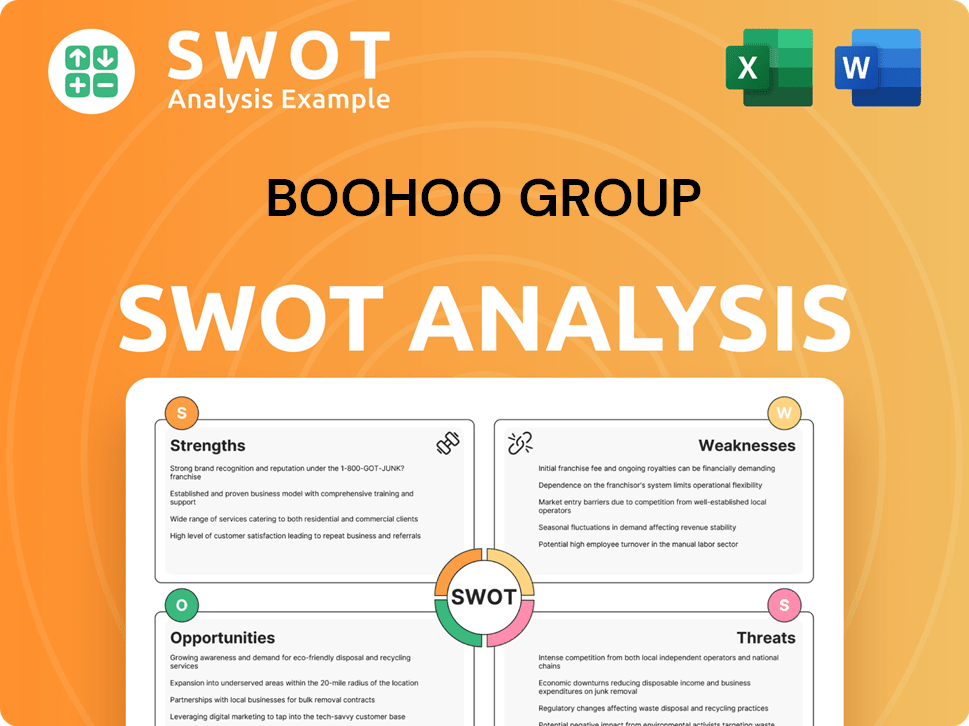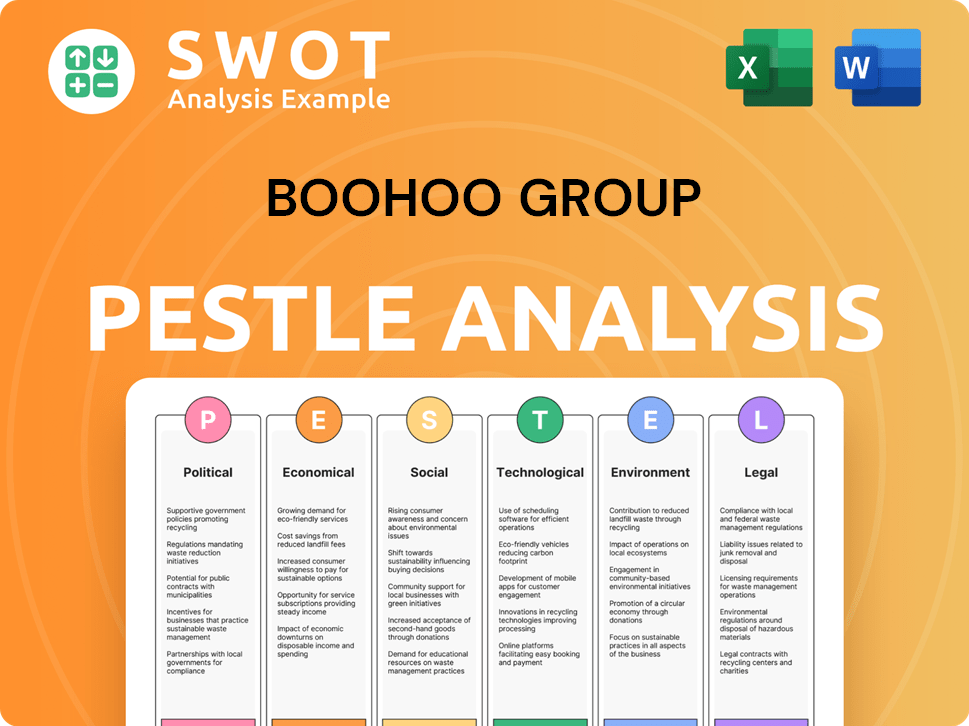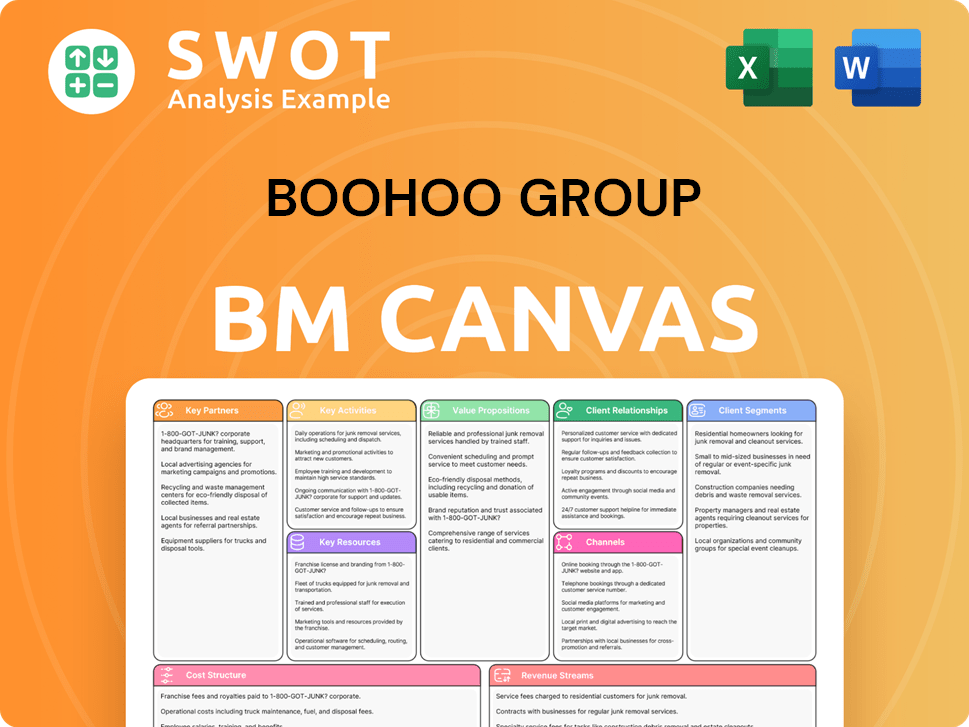boohoo group Bundle
Can Boohoo Group Continue Its Fast Fashion Ascent?
Boohoo Group PLC revolutionized the e-commerce fashion industry, rapidly becoming a global force in online retail. Founded in 2006, the company's success is built on offering trend-led fashion at affordable prices, primarily targeting a younger demographic. But what does the future hold for this fast fashion giant?

This boohoo group SWOT Analysis will explore the boohoo group growth strategy, examining its expansion into new markets and product categories. We'll analyze its strategic use of technology and innovation, alongside its financial outlook, to understand the boohoo future prospects. A deep dive into the boohoo company analysis will reveal the key drivers behind its past success and the strategies it's employing to maintain its momentum in the competitive online retail market, including its approach to fast fashion trends.
How Is boohoo group Expanding Its Reach?
The Owners & Shareholders of boohoo group are actively pursuing several expansion initiatives to broaden its market reach and diversify its revenue streams. A key element of their growth strategy involves international expansion, with a focus on strengthening its presence in key global markets. While specific new geographical market entries for 2024-2025 haven't been detailed, the company continuously assesses opportunities to penetrate underserved regions or deepen its existing footprint where market conditions are favorable. This often involves localized marketing campaigns, optimized logistics, and tailored product assortments to resonate with regional consumer preferences.
Beyond geographical expansion, the boohoo group growth strategy also focuses on product category diversification and the potential for strategic mergers and acquisitions. The company has a history of acquiring distressed fashion brands, integrating them into its platform, and leveraging its operational efficiencies to revitalize them. For instance, in recent years, the company acquired brands like Debenhams, Dorothy Perkins, Burton, and Wallis, expanding its customer base and product offerings beyond its core youth demographic. While no major acquisitions have been announced for early 2025, the company's strategy indicates a continued openness to such opportunities to consolidate its market position and access new customer segments. Furthermore, the boohoo group aims to enhance its product pipelines by continually introducing new trend-led items and expanding into complementary categories such as beauty and homeware, thereby increasing customer lifetime value and attracting new demographics.
The online retail market is dynamic, and the boohoo group's future prospects depend on its ability to adapt to fast fashion trends and consumer preferences. The company's expansion strategies in new markets are crucial for maintaining revenue growth. The boohoo group's digital marketing strategy and brand awareness strategies are also vital in attracting new customers and retaining existing ones. The boohoo group's financial performance will be a key indicator of the success of these initiatives.
The boohoo group's expansion initiatives include international growth, product diversification, and strategic acquisitions. These strategies are designed to enhance the company's market position and revenue streams. The company's ability to manage its supply chain management and adapt to the competitive landscape analysis will be critical for success.
- International Expansion: Focus on key global markets with localized marketing and product offerings.
- Product Diversification: Expanding into new categories like beauty and homeware.
- Strategic Acquisitions: Acquiring and integrating fashion brands to broaden the customer base.
- Customer Acquisition: Utilizing digital marketing and brand awareness strategies.
boohoo group SWOT Analysis
- Complete SWOT Breakdown
- Fully Customizable
- Editable in Excel & Word
- Professional Formatting
- Investor-Ready Format

How Does boohoo group Invest in Innovation?
The boohoo group growth strategy heavily relies on innovation and technology to maintain its competitive edge in the dynamic e-commerce fashion industry. This focus is crucial for adapting to the ever-changing fast fashion trends and meeting the demands of the online retail market. The company's ability to quickly respond to fashion trends and customer preferences is a key driver of its success.
Digital transformation is at the core of boohoo's operations, with significant investments in its e-commerce platforms. These platforms are designed to enhance user experience, streamline the purchasing process, and provide personalized recommendations. Automation in warehousing and logistics further supports rapid order fulfillment and efficient inventory management, which are essential for a fast-fashion business model.
The company is also exploring the use of artificial intelligence (AI) to improve its operations. AI is applied in areas such as trend forecasting, pricing optimization, and personalizing the customer journey through data analytics. While specific details about AI patents or awards for 2024-2025 are not readily available, the industry trend suggests a strong focus on AI-driven insights to improve product development and marketing effectiveness.
Continuous upgrades to the e-commerce platform are vital for improving user experience. This includes faster site speeds, easier navigation, and enhanced mobile compatibility. These improvements help to increase conversion rates and customer satisfaction.
AI is used to analyze customer data and offer personalized product recommendations. This leads to increased sales and a more engaging shopping experience. Personalized marketing campaigns also improve customer retention.
Automated systems in warehouses optimize order fulfillment and inventory management. This reduces processing times and ensures timely delivery. Efficient logistics are crucial for meeting customer expectations.
Efforts to reduce environmental impact are integrated into the technology strategy. This includes sustainable materials and production methods. This approach aligns with growing consumer demand for ethical fashion.
AI-powered data analytics tools are used to predict emerging fashion trends. This allows the company to quickly adapt its product offerings. Accurate trend forecasting minimizes risks and maximizes sales.
Technology is used to optimize the supply chain for greater efficiency and reduced waste. This includes tracking materials and streamlining production processes. Improved supply chain management lowers costs and enhances sustainability.
Sustainability is also a key focus, with technology playing a role in optimizing supply chains to reduce environmental impact. This includes exploring more sustainable materials and production methods, reflecting the growing consumer demand for ethical and environmentally conscious fashion. These technological advancements and innovative approaches are directly aligned with boohoo's growth objectives, improving operational efficiency, enhancing customer satisfaction, and enabling faster responses to evolving market trends, thus helping to maintain its competitive edge. For a deeper dive into the company's strategies, you can explore a detailed boohoo company analysis.
The company's approach to technology and innovation is multifaceted, focusing on enhancing various aspects of the business from customer experience to operational efficiency. These strategies are designed to support the company's boohoo future prospects.
- E-commerce Platform Development: Continuous improvements to the online shopping experience, including faster site performance, mobile optimization, and user-friendly interfaces.
- AI and Machine Learning: Implementation of AI for trend forecasting, personalized product recommendations, and dynamic pricing strategies.
- Supply Chain Optimization: Utilizing technology to improve inventory management, reduce lead times, and enhance supply chain visibility.
- Sustainability Initiatives: Integrating sustainable practices into the supply chain, including the use of eco-friendly materials and reducing waste.
- Data Analytics: Leveraging data analytics to understand customer behavior, optimize marketing campaigns, and improve product development.
boohoo group PESTLE Analysis
- Covers All 6 PESTLE Categories
- No Research Needed – Save Hours of Work
- Built by Experts, Trusted by Consultants
- Instant Download, Ready to Use
- 100% Editable, Fully Customizable

What Is boohoo group’s Growth Forecast?
The financial outlook for the boohoo group highlights a period of adjustment and strategic realignment within the e-commerce fashion industry. The company's recent performance reflects the challenges of the online retail market, particularly in a post-pandemic environment. Understanding the boohoo group's financial performance is crucial for assessing its future prospects and growth strategy.
According to the trading update for the three months ended February 29, 2024, the boohoo group reported a net revenue decrease of 17% for the full year, with revenue reaching £1,461 million. This decline underscores the impact of changing consumer behavior and economic pressures. The company is actively working on strategies to navigate these challenges and return to sustainable revenue growth.
The company's gross profit margin improved by 100 basis points to 53.6%, indicating improved operational efficiency despite revenue declines. The boohoo group is focused on optimizing its business model and cost management. The company's financial narrative suggests a cautious but optimistic outlook, with an emphasis on disciplined cost management and a gradual return to top-line growth. For a deeper dive into the company's target audience, consider reading about the Target Market of boohoo group.
The boohoo group's net revenue decreased by 17% for the full year, reaching £1,461 million. The UK revenue decreased by 18% to £836 million. International revenue also decreased by 16% to £625 million. These figures reflect the current market dynamics and the need for strategic adjustments.
The company's gross profit margin improved by 100 basis points to 53.6%. This improvement indicates effective cost management and operational efficiencies. The focus on profitability is a key element of the boohoo group's growth strategy.
boohoo anticipates a return to revenue growth in the financial year ending February 2025. Projections range from flat to a low-single-digit increase. The company expects an adjusted EBITDA margin of 4% to 4.5% for FY25. These projections highlight the company's strategic focus on improving profitability.
The boohoo group is committed to optimizing its business model and managing inventory levels more effectively. The company is also leveraging its strong brand portfolio to drive sustainable growth. These strategies are designed to position the company for long-term success in the fast fashion trends market.
The financial performance of the boohoo group is characterized by several key metrics that provide insight into its current position and future prospects. These metrics are critical for understanding the boohoo group's growth strategy and its ability to navigate the competitive landscape of the online retail market.
- Revenue: Total revenue for the full year decreased by 17% to £1,461 million.
- UK Revenue: Revenue in the UK decreased by 18% to £836 million.
- International Revenue: Revenue in international markets decreased by 16% to £625 million.
- Gross Profit Margin: Improved by 100 basis points to 53.6%.
- FY25 Projections: Anticipated revenue growth ranging from flat to a low-single-digit increase.
- Adjusted EBITDA Margin (FY25): Expected to be between 4% and 4.5%.
boohoo group Business Model Canvas
- Complete 9-Block Business Model Canvas
- Effortlessly Communicate Your Business Strategy
- Investor-Ready BMC Format
- 100% Editable and Customizable
- Clear and Structured Layout

What Risks Could Slow boohoo group’s Growth?
The success of the boohoo group growth strategy hinges on navigating several potential risks and obstacles. The e-commerce fashion industry is fiercely competitive, and the online retail market is constantly evolving. The company must adeptly manage these challenges to maintain its growth trajectory and achieve its boohoo future prospects.
Regulatory changes and supply chain vulnerabilities also pose significant threats. Increased scrutiny regarding environmental, social, and governance (ESG) standards and global events can disrupt operations. Internal resource constraints and the adoption of new technologies further complicate the landscape.
The boohoo company analysis reveals that its ability to mitigate these risks will be crucial for its long-term success. Continuous adaptation and strategic foresight are essential to overcome these hurdles and capitalize on growth opportunities. The company's performance is closely tied to its ability to address these challenges effectively.
The fast fashion trends market is highly competitive, with numerous players vying for market share. Price wars and margin pressures are common, requiring constant innovation and efficiency. Maintaining a competitive edge in this environment demands strong brand awareness strategies and effective customer acquisition strategies.
Regulatory changes, particularly concerning ESG standards, pose a risk. Increased focus on labor practices and sustainability can lead to higher compliance costs. The company must invest in sustainability initiatives to mitigate reputational and financial risks.
Supply chain disruptions can cause delays, increased costs, and inventory issues. The company needs to enhance supply chain management to ensure resilience. Addressing these vulnerabilities is critical for maintaining operational efficiency and meeting customer demand.
Technological advancements can disrupt the e-commerce fashion industry. Competitors may outpace the company in adopting new platforms and technologies. Staying ahead requires a robust digital marketing strategy and continuous investment in technology.
Limited access to skilled talent or capital can hinder growth initiatives. Efficient resource allocation and strategic investment are crucial for scaling operations. Overcoming these internal constraints is vital for achieving long-term growth objectives.
Ethical sourcing issues can lead to increased scrutiny and reputational damage. The company must strengthen ethical sourcing practices and transparency. Addressing these challenges is essential for maintaining consumer trust and brand reputation.
The company employs several strategies to mitigate risks. Diversifying its brand portfolio reduces reliance on any single market segment. Continuous investment in risk management frameworks and scenario planning helps anticipate and respond to potential disruptions. Strengthening supply chain resilience and ethical sourcing practices is also crucial.
boohoo group financial performance is closely tied to its ability to manage these risks. The company's revenue growth and market share depend on effective risk management. The company’s performance in 2024 and 2025 will be a key indicator of its ability to navigate these challenges. For example, in the fiscal year ending February 2024, the group reported revenue of £1.77 billion, a decrease of 17% compared to the previous year, reflecting the impact of macroeconomic headwinds and strategic decisions. In the same period, adjusted EBITDA was £62.9 million, with a focus on improving profitability and cash flow. The company is actively focusing on cost efficiencies and strategic initiatives to improve its financial outlook.
Understanding the competitive landscape is crucial for success. The Competitors Landscape of boohoo group reveals the key players and their strategies. Analyzing the competitive landscape analysis helps in formulating effective boohoo expansion strategies in new markets. The company's ability to differentiate itself in a crowded market is essential for sustained growth.
boohoo group growth opportunities are significant, but they come with challenges. The ability to adapt and innovate is crucial for long-term success. The company's future prospects depend on its ability to overcome these challenges and capitalize on emerging trends. The company's strategic initiatives and financial performance will be key indicators of its future trajectory.
boohoo group Porter's Five Forces Analysis
- Covers All 5 Competitive Forces in Detail
- Structured for Consultants, Students, and Founders
- 100% Editable in Microsoft Word & Excel
- Instant Digital Download – Use Immediately
- Compatible with Mac & PC – Fully Unlocked

Related Blogs
- What are Mission Vision & Core Values of boohoo group Company?
- What is Competitive Landscape of boohoo group Company?
- How Does boohoo group Company Work?
- What is Sales and Marketing Strategy of boohoo group Company?
- What is Brief History of boohoo group Company?
- Who Owns boohoo group Company?
- What is Customer Demographics and Target Market of boohoo group Company?
Disclaimer
All information, articles, and product details provided on this website are for general informational and educational purposes only. We do not claim any ownership over, nor do we intend to infringe upon, any trademarks, copyrights, logos, brand names, or other intellectual property mentioned or depicted on this site. Such intellectual property remains the property of its respective owners, and any references here are made solely for identification or informational purposes, without implying any affiliation, endorsement, or partnership.
We make no representations or warranties, express or implied, regarding the accuracy, completeness, or suitability of any content or products presented. Nothing on this website should be construed as legal, tax, investment, financial, medical, or other professional advice. In addition, no part of this site—including articles or product references—constitutes a solicitation, recommendation, endorsement, advertisement, or offer to buy or sell any securities, franchises, or other financial instruments, particularly in jurisdictions where such activity would be unlawful.
All content is of a general nature and may not address the specific circumstances of any individual or entity. It is not a substitute for professional advice or services. Any actions you take based on the information provided here are strictly at your own risk. You accept full responsibility for any decisions or outcomes arising from your use of this website and agree to release us from any liability in connection with your use of, or reliance upon, the content or products found herein.